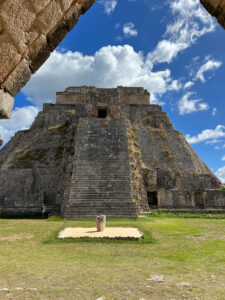
There are so many options for incredible day trips from Merida that I had a very difficult time choosing which ones to do. And even though I was in Merida for two weeks, I still couldn’t fit in all the day trips I wished I could. I ended up doing two organized tours: one to Uxmal and the Chocolate Museum and one to Izamal and several cenotes. The Uxmal and Chocolate Museum Tour cost about $60 (USD) which included lunch, the tour guide, and transportation but NOT the tickets for Uxmal or the Museum. The Izamal and 5 Cenotes Tour cost about $75 and DID included tickets for all the cenotes as well and our tour guide, transportation, and lunch. Is it possible to see all these places for less money? Yes, for sure. But these prices felt very fair, especially for the convenience.
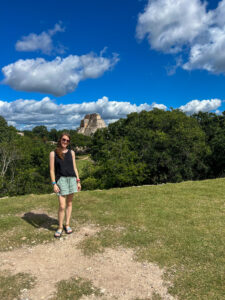
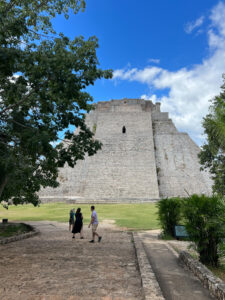

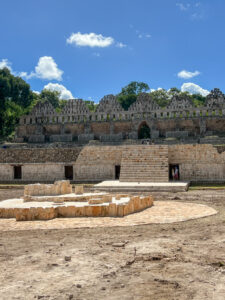
The Mayan Ruins at Uxmal
The Pyramid of the Magician at Uxmal looks like it grows out of the jungle. I assumed there would be hordes of tourists, but there were only a few scattered groups of people, quiet amidst the scampering iguanas. I’d considered trying to visit Uxmal on my own, but I’d heard too many accounts of how difficult this was without a car, so I opted for an organized tour instead. Our tour guide from Edith’s Tours (the local company that all the hostels and hotels in town promote) picked me up from my hostel lobby, and the group of us rode in a van the hour and a half to Uxmal. I imagine that it doesn’t look much different today than it did when explorers found it in the 1800s.
Over 1300 years ago, Uxmal was home to 25,000 people. Today it’s one of the more famous and best-preserved Mayan ruin complexes on the Yucatan Peninsula and one of the must-see sights for anyone using Merida as a base for their day trips. Our guide led us around and taught us the history of Uxmal in both English and Spanish before giving us free time to wander on our own. The Mayan people were some of the world’s greatest mathematicians, and our guide spent a while trying to explain some complicated math involved in the design and meaning of the place. His scribbled diagrams and equations lost me entirely, but I was impressed nonetheless.
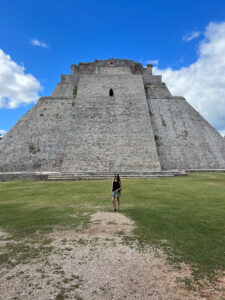
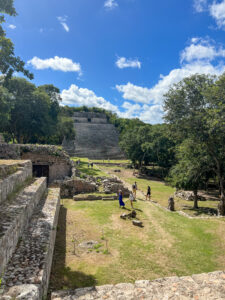
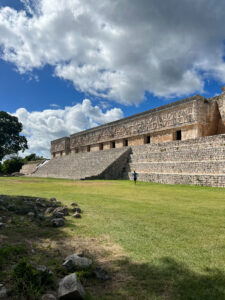

I hadn’t realized how large Uxmal would be and how far the ruins would sprawl into the forest. Visitors aren’t allowed to climb the largest pyramid, but you are allowed to climb a few other structures in the complex, and while following my group up the steep stairs of the House of Turtles complex, I got such bad vertigo that I had to sit for a minute then try again. The iguanas watched from the bushes and judged me.
At the Pyramid of the Magician, the acoustics were designed so that when you clap at the base of the pyramid, you hear the call of the Mayan’s sacred bird, the Mexican quetzal, answering back. I was not prepared for this magic. I’d heard about the famous “bird chirp” at the pyramid in Chichen Itza (the most famous of Mexico’s Mayan ruins and one of the New Wonders of the World), but I hadn’t known that the mysterious bird call would be waiting for me in Uxmal, too. There is nothing that prepares you for the haunting feeling of standing at the base of an ancient pyramid in the quiet forest listening to a person clap at the pyramid and hearing the pyramid respond.
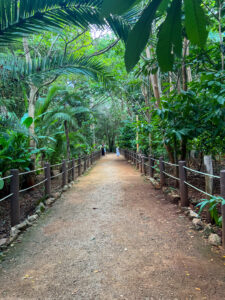
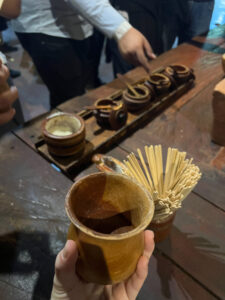
Choco Story—the Chocolate Museum
After leaving Uxmal, half of our group went to visit the nearby ruins of Kabah while the rest of us went to Choco Story—the Chocolate Museum. I had assumed the Chocolate Museum might be a little silly, but it was entirely different than I expected. It was less a museum than it was a nature walk with informative huts and exhibits to visit on the path. Choco Story is also an animal rescue, and they house animals who have been harmed or mistreated and can’t be released back into the wild. For about 5 cents, you can buy a handful of food to hand to the group of very enthusiastic spider monkeys.
The journey through the exhibits teaches guests about the history of cacao and chocolate, the significance of cacao to the Mayan people, and the evolution of how chocolate came to be what it is today. We got to see a Mayan Cacao Ceremony—a spiritual ceremony practiced throughout the Mayan world—and we got to taste the Mayan beverage Chokoj Ha, which is basically just hot water and unsweetened chocolate and is frankly disgusting unless you add A LOT of sugar and spices to it.
A multi-course group lunch was included in our tour ticket price, and then we headed to our final stop of the day—my first underground cenote.
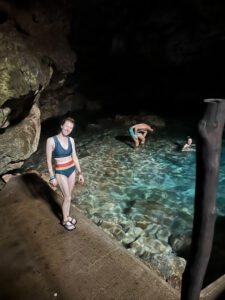
Cenotes
When you try to describe a cenote to someone who’s never seen one, they sound terrifying. They’re deep holes in the ground, sometimes in caves and sometimes open to the air, filled with water and fish and darkness and perhaps some long-buried treasures or, you know, human remains that we just haven’t found yet. And doesn’t that sound like exactly where you want to go swimming? But the mystery of cenotes (pronounced like sin-oh-tays) is part of what makes them so beautiful.
The Yucatan Peninsula is famous for its cenotes. It has around 10,000 of them—the highest concentration of them in the world. Scientists think the cenotes here were created because of the impact of the asteroid that hit right off the coast and caused the ice age that killed the dinosaurs. The impact of the asteroid weakened the limestone, and over time, the limestone collapsed in places due to water erosion and underground water currents. So now, the Yucatan looks like a piece of Swiss cheese speckled with holes. The ancient Mayans believed these were sacred places, both because they were a fresh water source and because they believed they were entrances to the underworld. But the underworld didn’t mean hell for them. It was a place where the gods lived. They often made offerings to the gods in cenotes and occasionally human sacrifices.
Merida sits in the center of a giant ring of cenotes (the outer edge of the crater caused by the asteroid), so it feels like there are endless options of cenotes to visit. Some of the more popular cenotes are operated like big tourist attractions with crowds and restaurants and gift shops, but the one our tour group brought us to looked like it was family-run and just had a few changing rooms and bathrooms. We were nearly the only ones there, and the long climb down into the cave was a little disturbing. Once inside though, the water was so clear you could see straight to the bottom.

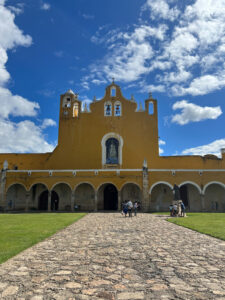
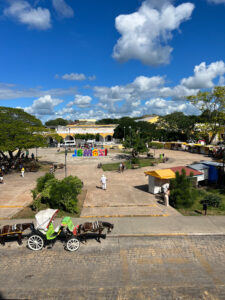
Izamal, the Yellow City
I wanted to see more cenotes, so the next day, I took another of Edith’s Tours with a different group—this time to see Izamal and 5 cenotes.
This time, I was the only person on the entire tour who didn’t speak Spanish. I felt very grateful for my sweet tour guide who gave the entire tour in Spanish and then recapped in English one-on-one for me. I was the only solo traveler in the group, and everyone went out of their way to make sure I felt included despite any language barriers. When one of my tourmates discovered that I’d never tried Mexican horchata, he bought an entire pitcher of it at lunch and had the waiter bring an extra cup for me.
We visited Izamal first, a town known as the Yellow City because all the buildings are painted yellow. Not just any yellow, but a vibrant, blinding shade of mustard. It’s quite a spectacle. Right in the center of town sits a giant pyramid—a massive Mayan ruin that you can freely explore. Visitors are free to climb up to the top of the pyramid for the view. (No, of course I didn’t.) I stood safely on the ground with the tour guide and asked her if people ever fall off. She said only sometimes. (Don’t climb pyramids if you have a fear of heights and vertigo, friends.) We explored the very large and very yellow Convent of San Antonio before heading to the cenotes.
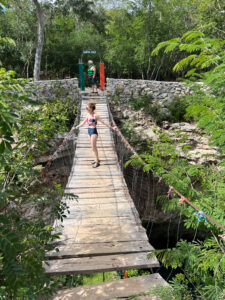



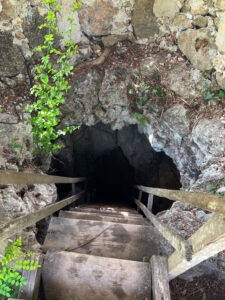
Santa Cruz and Santa Barbara Cenotes
And then it was time for the highlight of the day—the cenotes. We headed to Homun, a town famous for its cenotes. There are so many cenotes in the Homun area to choose from that it’s a popular day trip from towns like Merida and Valladolid. We visited two clusters of cenotes—the Santa Cruz cenotes where there were two cenotes connected by a tunnel and the Santa Barbara cenotes, a group of three of the most popular cenotes in the region. At the Santa Cruz cenotes, we had the place largely to ourselves, then at Santa Barbara, we finally found the crowds. But the crowds didn’t diminish how beautiful the place was.
I was consistently impressed with how well the cenotes are taken care of. Everyone pays an entrance fee that contributes to the upkeep of the cenotes, and everyone is required to take a thorough shower under the outdoor shower heads before entering because you aren’t allowed to get in the water with any chemicals on your body (from sunscreen, lotion, perfume, or deodorant). Everyone is required to wear a life jacket, no matter how well you can swim. Some of the cenotes are alarmingly deep, and there can be deep underwater currents that connect them to one another.
At Santa Barbara, horse-drawn wagons carry passengers between the 3 cenotes, and when you get tired, you can head to the full-service restaurant on site. I visited 10 different cenotes during my 3 weeks in Mexico, and it’s very hard to pick a favorite, but despite their crowds and popularity, the Santa Barbara cenotes are surely some of the most beautiful.
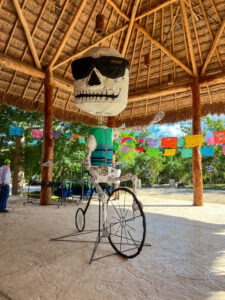
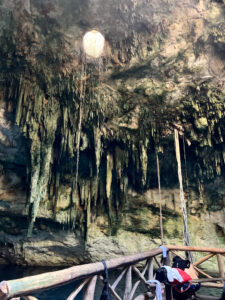

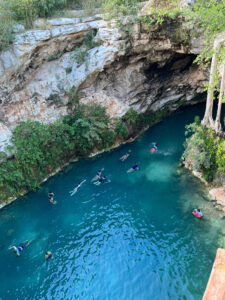
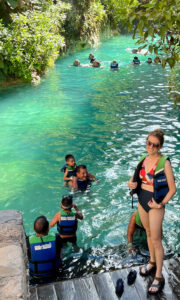
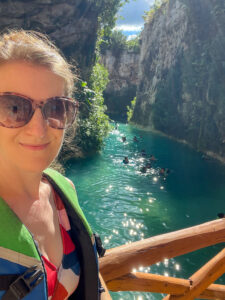
I think that tourists who only go to Merida for a day or two to use it as a base for day trips are missing out on an incredible city. BUT it would also be a wasted opportunity to not take advantage of one of the dozens of day trips available within an hour or two of Merida. I’d encourage anyone visiting Merida to give themselves at least a couple days in the city PLUS a couple more days to devote to day trips. Good luck to you deciding what those day trips will be because I could have stayed for months trying to do all the day trips I wished I could do.
(I will note that a lot of visitors would say that the number 1, can’t-miss day trip from Merida is to see Chichen Itza. The only reason I didn’t see it as a day trip from Merida is because I visited it from Valladolid later. Stay tuned for those upcoming blog posts!)
